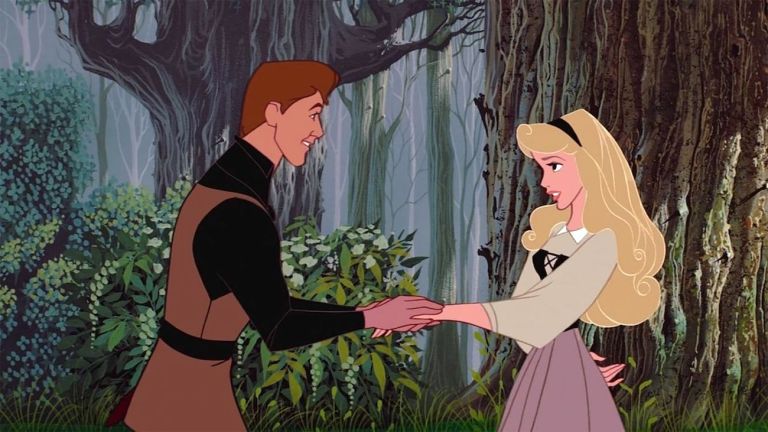Disney’s Sleeping Beauty Is Feminist, Actually
Despite featuring one of the most passive princesses of Disney's early animated classics, Sleeping Beauty is actually surprisingly feminist when you know who the real main character is...

At first glance, Sleeping Beauty seems among the Disney Princess films least likely to live up to the modern era of feminist storytelling. The titular character, Princess Aurora, has so little agency in the film that falling into a cursed sleep seems like a continuation of her early years. Aurora never gets a chance to choose her own destiny. So how could anyone make a case for this as a feminist film?
The answer to that, dear readers, is that the film isn’t about Princess Aurora at all. The film isn’t about supposed hero Prince Philip. It’s about an epic struggle between good fairies and an evil one. The Disney version of Sleeping Beauty is about a political divide in the world of fairies: those that bestow their blessings on humanity, and those who consort with monsters. And all of the major players in this struggle are women.
Flora, Fauna, and Merryweather
The seemingly middle-aged fairies are not the willowy young women viewers expect as their heroes in a Disney film. Consider that Sleeping Beauty appeared in theaters in 1959; other films of that year included Marilyn Monroe’s Some Like It Hot and Lana Turner’s Imitation of Life. The three good fairies have the body shapes of characters normally relegated to comic relief—which they do provide, and which is probably why so few people have noticed that they are the stealth heroes of the film.
Flora is the leader of the three, much to the younger-appearing Merryweather’s disgruntlement. Flora thinks ahead, coming up with solutions to problems, understanding how to manage the expectations of humans when they encounter the dangers of the fairy world. Fauna, scatterbrained and friendly, is a supportive and loyal second in command; she rarely takes her own initiative, but she’s a strong right hand for Flora. Merryweather is the most likely to think outside the box, and her impulsive behavior (and willingness to directly combat the forces of evil when she can get away with it), give the trio an edge.
If this description sounds a bit like another magical trio—the original Witches coven of Terry Pratchett‘s Wyrd Sisters come to mind—this may just establish that there’s a solid reason to think that middle-aged and older women with magic make formidable heroines. Just ask Granny Weatherwax. Or the original weird sisters in Shakespeare.
As Sleeping Beauty opens, baby Aurora is having her christening, to which the good fairies have been invited. Given the era in which they live, they know that while fairies may not need great beauty to succeed, a human princess could certainly use that to her advantage, and so Flora (always in the lead) gives her the gift of beauty. Fauna, equally aware of the role that music plays in courtly life (and the high expectations nobles are held to), grants Aurora the gift of song. Merryweather probably would have given Aurora something equally politically advantageous to a young royal, but alas, Maleficent appears on the scene, so we’ll never know.
Maleficent
Three good fairies stand on one side of the equation; the other side of the scale is balanced by a single evil power: Maleficent. In all of film, few villains loom as large across the story as Maleficent; I put her in league with Darth Vader for her sheer presence in the narrative. Voiced by the excellent Eleanor Audley, who was at the time 55 (again, a middle-aged woman, though Maleficent has a sense of agelessness), Maleficent is a gloriously threatening alto. She is at once smarter than all the minions that surround her but too disdainful to find out if they’re correctly doing their jobs. (Audley, it should be mentioned, also was the voice of the villainous Lady Tremaine in Cinderella.)
It’s no surprise that of all the characters in Sleeping Beauty, Maleficent is the one who starred in a live-action adaptation. But though Angelina Jolie was a striking Maleficent, the film shifted the focus from good fairy/bad fairy conflict to fairy/human conflict, which also shifted the major conflict to between a female fairy and a male human. (It also, according to the Den of Geek review at the time, gave Maleficent a less consistent character.) Despite lackluster critical opinion, the film was enormously financially successful, and the sequel (while still not a hit with with us) transferred the primary conflict back into the hands of its female characters.
Good vs. Evil
But back to the original. Merryweather’s quick thinking dulls, but doesn’t undo, Maleficent’s more powerful spell. While the good fairies do seem a little bumbling, there is no question that they’re more in control than anyone else in the narrative, save perhaps Maleficent. When they announce to Princess Aurora’s parents that they’ll be taking their daughter to raise her like a peasant, the royals accept this instantly. King Stefan makes plans to try to foil Maleficent’s spell by eliminating spindles, probably upsetting the economy of his entire kingdom in the process, but he defers to the expertise of the fairies and entrusts them instantly with his daughter.
The fairies themselves give up magic for 16 years, so they will remain hidden, sacrificing their nature in order to keep the child safe. It’s their magic that ultimately gives them away; they have the best of intentions to give their charge a happy birthday before they up-end her life. They, of course, assume news of her royal heritage will be a wonderful surprise instead of causing her heartbreak. Ironically, they’re belief that a human girl would be excited to be a princess, shows how they can undervalue their own importance in her life. (Also there’s a boy involved. Don’t blame Aurora: she’s only 16 and a McGuffin.)
No matter what the fairies did, however, Aurora would always fall into Maleficent’s trap, because magic. Yet when the spell falls over the girl, the fairies are able to still buy themselves some time. They set the whole kingdom to sleep, so that by the time they have the problem fixed and deal with Maleficent, no humans will know any better. They just need a tool, and there’s that convenient human boy in love with their foster daughter—he’ll do! (To give Prince Philip credit, he’s also very forward-thinking; he gives his father trouble about the inherent classism of feudalism.)
Of all the early Disney princes—and several of the later ones—Philip is the most unquestionably heroic, ready to fight evil and save Aurora at the behest of the good fairies. The battle of Prince Eric (The Little Mermaid) against the gigantic version of Ursula the Sea Witch is clearly modeled after the face-off between Philip and the dragon version of Maleficent. But there’s no way a mere prince would have won that battle without the fairies bestowing him with magic weapons. The fairies needed to take on Maleficent; they considered reasoning with her, and Merryweather considered turning her into a toad, only to be reminded by Flora, “You know our magic doesn’t work that way.” Their magic does work, however, to empower humans—reminiscent of how the Greek gods play out their quarrels in the Trojan War, albeit here on a smaller scale.
Few viewers would ever consider Princess Aurora herself a feminist icon. But the take-charge women who are really the film’s protagonists show that middle-aged women can have agency beyond as mothers or wives. They can shape the destinies of nations, and even if something is beyond their power directly, they can empower others to do the impossible.
